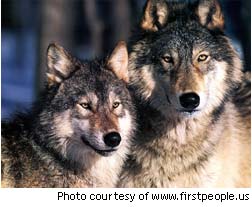Which Wolf Have You Been Feeding? Two Wolves
“It is a terrible fight and it is between two wolves. One is full of anger, envy, sorrow, regret, greed, arrogance, self-pity, guilt, resentment, inferiority, lies, false pride, and superiority.” He continued, “The other stands for joy, peace, love, hope, serenity, humility, kindness, benevolence, empathy, generosity, truth, compassion, and faith.” “Sometimes, it is hard to live with these two wolves inside me, for both of them try to dominate my spirit. The same fight is going on inside you and inside every other person, too.” The boy paused in deep reflection and then asked his grandfather, “Which wolf will win?” The elder Cherokee smiled and replied, “The one you feed.” The Power to Decide This story provides a striking metaphor for the beliefs we possess that impact our actions and for that matter, our experience of life. What’s most significant is not that an internal struggle exists but that we have the power to decide which thoughts to nurture. In my own life and in my work with many others, I’ve noticed that this aspect of the coaching process produces the most pivotal changes. Learning how to transform limiting beliefs and manage unproductive thoughts is always followed by significant forward movement because our actions flow from our thoughts. Are some thoughts beyond our control? Yes, and the best approach for those is to simply acknowledge them, consider whether they have any merit, and then let them float by. That’s another type of skill to master. The great thing is that we can train ourselves to think in ways that are much more useful. Feed the Right Wolf There are beliefs, assumptions, and thoughts that serve you and those that do not. You actually can learn to manage and to optimize your beliefs. This Week: Raise your awareness, notice what you are thinking, and identify thoughts that are unproductive. One way you can do this is to bring to mind something you’d like to do or have that feels like a stretch and even a bit daunting. Then, write down the thoughts that occur to you when you consider the possibility of actually achieving your goal. Take a look at what you’ve written and ask:
Sometimes it can be difficult to identify your own limiting beliefs because they’re so imbedded in your thinking. If this is the case, bring a trusted partner into the process. “Watch your thoughts, for they become
words. Here’s to you, Notes: |
||
|
||


